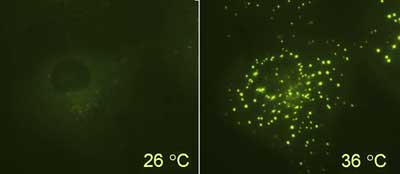A fluorescent polymer that can accurately measure the temperature inside living cells has been invented by researchers in Japan.
Seiichi Uchiyama and his group at the University of Tokyo have developed the heat-sensitive fluorescent polymer, which they have packaged in a chemically inert polymer gel. The gel can be injected directly into cells and used to detect variations in temperature as small as half a degree, without interfering with cellular functions. The gel's covering of hydrophilic sulfate groups ensures it disperses throughout the cytoplasm rather than sticking to the cell membrane.
'At the moment we can measure the average temperature of the cell as a whole,' explains Uchiyama, 'but we are working on attaching a localising agent (such as a peptide) to the surface so that individual organelles can be targeted more specifically. This will allow us to map the spatial and temporal variations in temperature within the cell.'

Fluorescence reveals temperature changes inside living cells © ACS |
The thermometer unit works by incorporating a water-sensitive fluorophore inside a thermally-responsive polymer. At low temperature the polymer has an open structure and absorbs water, which quenches the fluorescence. When it is heated, the polymer structure contracts, driving out the water and making the gel fluoresce. The level of fluorescence can be measured, revealing the temperature within the cell.
Previous molecular thermometers, employing europium complexes or green fluorescent protein, were hampered by poor thermal sensitivity, meaning that they couldn't really detect the subtle temperature variation accompanying biological processes. This lack of sensitivity, coupled with the fact that their output could be confused by variations in pH or ionic strength, limited their utility.
Prasanna de Silva from Queen's University in Belfast, UK, says Uchiyama's success in introducing the thermometer gel into living cells sets an excellent precedent for future applications of the technology. 'If you have a thermometer of such a small size, then you can put it into all sorts of interesting places. The demonstration that this gel functions inside a cell means that there's almost nowhere it can't go.
'I think people might have felt before that temperature was not worth measuring,' adds de Silva, 'because we expect it to be held constant most of the time. We are beginning to realise that, while the cell's buffering mechanisms do eventually work, there are short-term local effects. So if you can watch a cell in small spatial detail, with good time resolution then you can pick up on things which wouldn't be seen otherwise.'
The ability to measure variation in cell temperatures accurately will not only give insights into the intimate workings of the complex chemical systems at work within them, but also aid understanding and diagnosis of disease. 'Pathological cells are generally slightly warmer than normal cells because of their enhanced metabolic activity,' says Uchiyama. 'We're working on a way to get cells to absorb the thermometer gel from culture media, which would eliminate the need for microinjection and make it much more useful for diagnosis. We can also tune the solubility and functional temperature range to make the gel suitable for a wide range of cell samples.'
Phillip Broadwith
http://www.rsc.org/chemistryworld/News/2009/February/09020901.asp





Comments :
Post a Comment